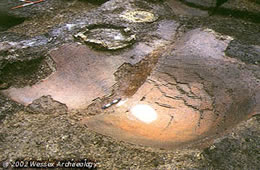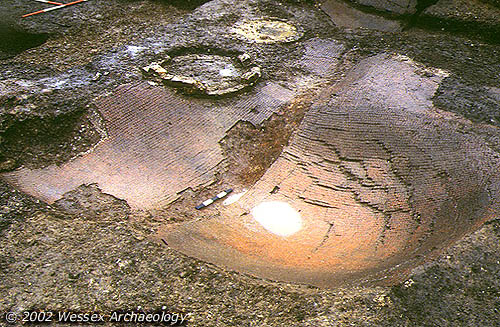51.433955, -0.512445

This project was an excavation of the north side of a Roman settlement at Staines where there was an important bridging point across the River Thames.

Wessex Archaeology carried out a five-year programme of archaeological excavation in a nine-hectare (22 acres) area to the north of the High Street, Staines, Surrey, on land formerly mainly occupied by the Central Trading Estate.
Almost all the archaeological remains found here related to the Romano-British settlement established in the second half of the 1st century AD, soon after the Roman invasion of Britain in 43AD. The settlement was built on a gravel island at an important bridging point across the Thames that formed the main route from London to the west of the Britain.
The early settlement flourished and expanded in the 2nd century AD but this was followed by a break in activity and an apparent contraction in the late 2nd/early 3rd centuries, although its occupation continued to the end of the Roman Empire in the 5th century.
 Excavation found that much of the land to the north of the main road was used to dump rubbish and as small-holdings. Animals were kept here and their grazing land extending into the rich meadows bordering the north side of the gravel island.
Excavation found that much of the land to the north of the main road was used to dump rubbish and as small-holdings. Animals were kept here and their grazing land extending into the rich meadows bordering the north side of the gravel island.
The single building recovered was built during the 2nd century on land previously used for digging rubbish pits. The unfortunate consequence of this can be seen from the collapse of the tessellated floor into the rubbish pits.
The economy of the town seems to have remained much the same throughout the Romano-British period, with most basic foodstuffs being brought in from the surrounding area.
Activity after Roman times was negligible until the 12th century, when people began using the eastern half of the main gravel island. Here, burgage plots were established – small-holdings, some used for horticultural purposes, others for storage and stabling and the keeping of animals. These were at right-angles to the course followed by the current High Street.
The works were funded by MEPC UK Ltd and monitored on their behalf by CgMs Consulting.

Excavations on the north side of the Romano- British settlement at Staines, an important bridging point across the River Thames

The single building recovered corresponds with the 2nd century phase of expansion.

The building was constructed on land previously used for digging rubbish pits. The unfortunate consequence of this can be seen from the collapse by up to 1m of the tesselated floor into the earlier pits.

The building was constructed on land previously used for digging rubbish pits. The unfortunate consequence of this can be seen from the collapse by up to 1m of the tesselated floor into the earlier pits.